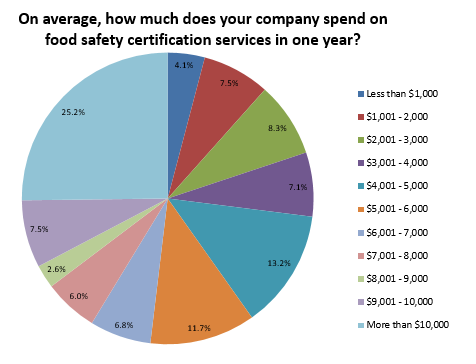Developing an internal audit program does not have to be a dauting task. With a small amount of work upfront a program can be developed and implemented in a matter of weeks. In this article we discuss the key elements of a successful program and provide guidance to ensure that audits add value to the daily operations across the facility.
Have a Plan in Mind
The first step in any successful audit program is to identify the overall structure and format. Audit programs can be set up in a variety of ways ranging from an annual full system audit to monthly departmental audits. The format and structure should be unique to each individual organization. Determine what works best for the organization and stick with it.
Developing a concise schedule will help to ensure expectations are clear. This schedule should be communicated with team members via appropriate channels. Identifying a point person to routinely follow up on the progress of the audits will ensure the program is being managed as expected. Considerations should be made for potential scheduling challenges. Build in additional time for those areas that are known to encounter delays.
Staying consistent with the maintenance and review of the program will ensure all audit activities are conducted within the expected timeframe. This can be accomplished by establishing a routine review of the program. Monthly review meetings can be established to review the audit schedule, results of audits and pending action items. During this time necessary adjustments can be made as needed and communication plans can be established. This helps to drive engagement across the organization around the entire audit program.
Accurate maintenance of audit records is a crucial step in maintaining a successful program. Ensure all records are properly filed and protected by establishing a designated filing system. Developing an organized file structure aids in keeping files in one place and reduces frustrations around locating documentation in the future. Be sure to include records for both internal and external audits as they are a required input to management review and may be needed for future assessments.
Build a Strong Audit Team
Having a good pool of auditors to pull from is critical. The number of auditors needed will vary based upon the size of the business and complexity of the processes. When considering the format of your team consider the backgrounds of the team members selected. There should be a good mix of experienced and new auditors to provide balance among the group. When assigning auditors to specific areas consider technical knowledge for those complex processes that may require a deeper understanding. Pairing auditors together is a great way for auditors to learn from each other as they work through the review of the data.
Auditing is often a required responsibility for QA/RA. Recruiting internal auditors from departments outside of QA/RA is beneficial, as they bring a different perspective and may ask questions that seem obvious to QA/RA professionals. All of the standards require auditors to be trained and/or competent in the auditing process. Training can be done externally or internally, and companies must show proof of training.
Selecting auditors from varying backgrounds is a great way to incorporate diversity within the team. Each auditor brings their unique experience to the group which builds a richer audit. Varying viewpoints helps to push the team to dig deeper to identify issues that may otherwise go unnoticed. Encourage the audit team to work together to build audit checklists that are specific to the area being audited. Conducting a review of the process and supporting documentation prior to the audit will enable the team to gain an understanding of the area under review. Encourage auditors to not become locked into the checklist but rather think of it as a guide. If audit trails within the scope of the audit arise during the audit be all means explore if time allows. This approach helps to empower the audit team by providing a sense of autonomy over their work.
When building the audit team, management should be mindful of the workload. For the program to be successful you want to ensure that audit team members are not overloaded. Often audits will be delayed due to competing responsibilities of auditors. To mitigate this issue, develop the audit schedule so there is a balance across the assigned audits. Ensuring that the auditor has plenty of time to conduct the audits within the specified timeframe. Overall, the audit team should feel supported and appreciated for their efforts and not be overwhelmed and burdened with the task. A poorly balanced workload only leads to a lack of interest and a disengagement among the audit team.
Provide Opportunities for Education
Providing an understanding of quality management systems and the standard being audited is imperative to the success of any audit program. There are two groups that require education. Education for the auditors and those that are participating in the audits. The auditors need an in-depth understanding of the standard and the requirements which they are auditing against. While the employees need awareness of how the management system is structured and their role in supporting it.
These educational goals can be accomplished both formally and informally across the organization. Auditors will need a more formalized structured training program that focuses on the details of the standard and auditing principles. While employee training can be incorporated into departmental meetings or shared through one-point lessons. Building education programs into existing activities is a great way of incorporating the audit program into the organizational culture. This helps to educate as well as share information with those in the organization who may otherwise not have awareness. This could be conducted via training sessions around processes and their linkage to the standard in which the organization is certified. Providing an understanding of the connections between the departments helps build collaboration between working groups. Employees gain exposure to what others in adjacent departments are doing and obtain a sense of understanding of challenges that may be faced by those groups. This in turn results in a collaborative team approach to the management of the overall system.
Involving employees from all parts of the business helps to drive the message that the system cannot operate in one department alone. Through education, employees will be able to understand their role in the system. This will lead to more engagement in the internal audit program. Employees will become excited to aid in audit activities and improvement initiatives because they will see positive results. They will gain understanding of the impact of their actions and how it impacts the overall system. This value-added approach will result in a favorable outcome for both the organization and the individual employees.
Promote Continuous Improvement
The support of top management is a very important element in the success of any audit program. Establishing a culture of continuous improvement will motivate the team and build engagement across the organization. This can be accomplished by frequently sharing status updates around the management system activities. A simple 15-minute update during sitewide meetings goes a long way. It demonstrates a commitment to the program and growth of the organization and its people.
Develop a format of communicating the details around the management system and any upcoming activities. This can be done by having a specific time each month when updates are provided. Putting this on the calendar will ensure that information is effectively communicated. Details should include both the negative and positive outcomes of internal and external audits. Include specifics around the audit findings and actions taken to address concerns. This will communicate to employees that the organization is serious about growing and is focused on improvement.
Sharing information helps to engage employees by bringing them into the improvement efforts rather than just being bystanders. These seemingly small actions can help drive excitement for the overall program and build a culture of quality. Lastly, be sure to celebrate the wins and ensure that team members are appreciated for their efforts. Building a successful internal audit program is a lot of work. Celebrating and acknowledging the efforts of the team is imperative.
Accomplish the Mission
There are many ways to build a successful internal audit program. Taking the time and effort to think through the process of identifying the format, structure and team members is critical. By reviewing these items upfront roadblocks can be identified early on. There will always be unforeseen challenges yet having a plan is key to developing a successful program. With a strong commitment from top management and a mindset of continuous improvement an organization can establish a robust internal audit program that exceeds expectations.







I presume you are talking about quality auditors in line with an ISO perspective, and not a true independent and objective internal audit function that reports to the Board of Director (through an Audit Committee) as is the case in most all public companies.